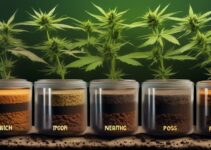Picture this: a lush, vibrant garden free from invasive weeds, all thanks to effective organic weed seed germination methods. You're eager to learn how to achieve this, and you've come to the right place. There are various techniques and conditions that can promote successful germination of weed seeds, and understanding these methods will empower you to cultivate a thriving, weed-free garden.
Key Takeaways
- Maintaining optimal soil temperature and moisture is crucial for successful weed seed germination.
- Light exposure, gaseous environment, and soil nutrients play a role in optimizing germination conditions.
- Shallow tillage is an effective method for weed control and management during germination.
- Experimenting with different organic germination techniques can help find the most effective method for individual growing conditions and preferences.
Soil Temperature and Water for Germination
To optimize weed seed germination, maintain an ideal soil temperature ranging between 70°F to 90°F and ensure adequate moisture potential in the soil. This temperature range is crucial as it directly influences the germination rates and timing of weed seeds. When the soil temperature falls within this range, it provides the optimal conditions for the seeds to lose dormancy and initiate germination. Additionally, the moisture potential in the soil plays a critical role in the timing and rate of weed seed germination. Hydrated seeds lose dormancy at a temperature-dependent rate, and the availability of water in the soil is essential for this process. It is important to note that fluctuating soil temperatures can influence seed dormancy and germination for different weed species, making it crucial to monitor and maintain the ideal temperature range consistently. When seeking to germinate weed seeds, ensuring the soil temperature falls within this specific range and maintaining adequate moisture levels in the soil is a fundamental method for promoting successful seed germination.
Light, Gaseous Environment, and Soil Nutrients
Light exposure, soil gaseous environment, and nutrient availability are critical factors influencing weed seed germination. When germinating cannabis seeds, consider the impact of these factors to ensure the best way to germinate your seeds.
- Light Exposure: Light plays a significant role in initiating the germination process. It can stimulate or inhibit weed seed germination based on the duration and intensity of exposure.
- Gaseous Environment: The soil gaseous environment, particularly nitrogen levels, regulates weed seed germination. Ensuring the right gaseous composition surrounding the seed is crucial for successful germination.
- Soil Nutrients: Nutrient availability, influenced by pH levels, directly impacts weed seed germination. Maintaining the correct balance of nutrients in the soil is essential for the best germination results.
When germinating cannabis seeds, using the paper towel method or rockwool cubes can provide the warm temperature and moisture potential required for successful germination. Understanding seed dormancy and the influence of temperature variations is crucial for successful cannabis cultivation. By carefully considering light exposure, gaseous environment, and soil nutrients, you can optimize the conditions for seeds to germinate effectively.
Importance of Tillage for Weed Emergence
The critical factors influencing weed seed germination, such as light exposure, gaseous environment, and soil nutrients, pave the way for a comprehensive understanding of the importance of tillage for weed emergence. Tillage timing, depth, and type play pivotal roles in influencing weed emergence. Shallow tillage is particularly emphasized as an effective weed control method, especially in the false seedbed technique. It serves as a cue to stimulate germination of weed seeds in the seedbank. By understanding the influence of tillage on weed emergence, it is possible to strategically delay weed and crop establishment until the main emergence flush has passed, contributing to effective weed management. Furthermore, ongoing research is essential to comprehensively understand all the factors influencing weed emergence and to develop more precise and effective tillage strategies for weed management. Incorporating these insights into organic weed seed germination methods can significantly impact the germination rate and ultimately contribute to successful organic weed control.
Selecting the Right Seeds
When selecting the right seeds for organic weed seed germination, it is crucial to start with high-quality seeds from reputable sources. Quality seeds are the foundation for successful cannabis growing. Consider the effects and demand of indica and sativa strains to align with your specific needs. Choose from a variety of strains available to find the ones best suited for your goals. Opt for feminized seeds to increase the chances of getting female plants, although it's important to keep in mind that feminized seeds don't guarantee 100% female plants.
To ensure the best conditions for germination and seedling development, it's essential to keep the seeds in a warm and moist environment. Using a heat mat can provide the consistent warmth necessary for the germination process. Additionally, viable seeds are essential for successful germination and the growth of healthy cannabis plants. By selecting high-quality, reputable seeds and considering the specific strains that align with your goals, you set the stage for a successful organic weed seed germination process.
Popular Organic Germination Techniques
Consider experimenting with various organic germination techniques to find the method that best suits your specific growing environment and preferences. When it comes to germinating weed seeds, there are several popular organic methods that you can try. The table below summarizes some of the best techniques for germinating cannabis seeds.
| Technique | Description | Benefits |
|---|---|---|
| Paper Towel Method | Involves moistening paper towels and placing the seeds between them in a dark place until they sprout | Provides a controlled environment for germination |
| Water Soaking | Requires soaking the seeds overnight in lukewarm water before planting directly in the ground or containers | Helps soften the seeds' outer shell for easier germination |
| Direct Planting | Involves planting the seeds directly in soil or containers | Suitable for those who prefer a simple approach |
These methods offer diverse options for germinating cannabis seeds and can be tailored to your specific preferences and growing conditions. Experimenting with different organic germination techniques can help you find the most effective method for your cannabis growing endeavors.
Frequently Asked Questions
What Are the Best Methods of Seed Germination?
To get the best seed germination, ensure soil moisture, proper temperature control, and seed soaking. Light exposure, air circulation, and humidity levels are crucial for successful seedling development. Seed scarification and stratification enhance germination success.
What Helps Seeds Germinate Faster?
To help seeds germinate faster, ensure proper soil moisture, control temperature, and provide adequate light exposure. Consider seed scarification, stratification, soaking, and use seedling heat mats, humidity domes, grow lights, and transplanting for optimal results.
What Are the 5 Factors That Affect Seed Germination?
Factors affecting seed germination include temperature and moisture, soil composition, light exposure, seed age, oxygen availability, seed dormancy, seed viability, and germination inhibitors. Understanding these factors is crucial for successful organic weed seed germination.





